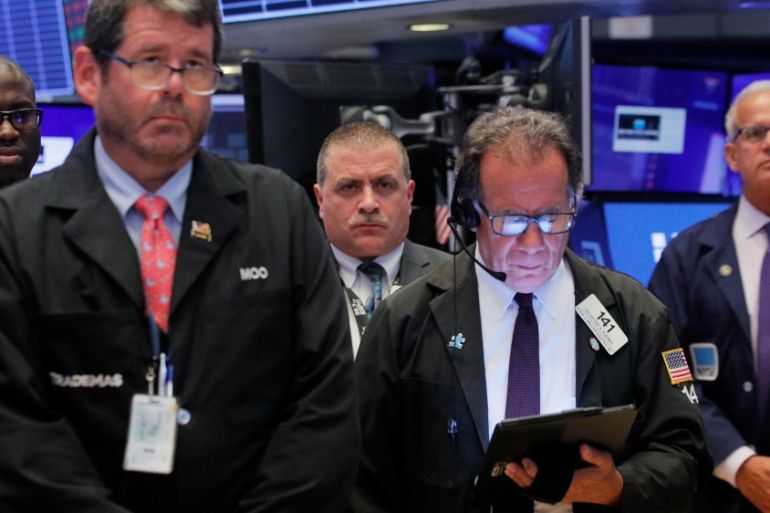The harder they fall: US-China trade war escalation roils markets
Stocks tumble as Beijing allows yuan to dive to 7-year low against US dollar.

Equity markets around the world fell hard on Monday, driven by fears that China’s willingness to let the yuan slide in response to the latest United States tariff threat could further exacerbate trade-related tensions between the world’s two largest economies.
China let the yuan slip below the key seven-per-dollar level on Monday for the first time in more than a decade. The move signaled that Beijing could be willing to allow further currency weakness after US President Donald Trump vowed last week to impose 10 percent tariffs on an additional $300bn of Chinese imports starting September 1.
Keep reading
list of 4 itemsEcuador weighs security, international arbitration in latest referendum
‘Triple spending’: Zimbabweans bear cost of changing to new ZiG currency
Boeing hit with 32 whistleblower claims, as dead worker’s case reviewed
“China dropped the price of their currency to an almost a [sic] historic low,” Trump tweeted on Monday. “It’s called ‘currency manipulation’,” he added, roiling markets about the possibility of further escalation.
Safe-haven assets – including the Japanese yen, US government bonds and gold – rallied as investors cut back on riskier assets.
“I think there’s a sense that President Trump might try and escalate in terms of a reaction, if he thinks that this was a deliberate move by the Chinese to try and weaken their currency artificially,” said Brian Daingerfield, head of G10 FX strategy for the Americas at NatWest Markets.
Against the Japanese yen, the US dollar fell 0.56 percent to its lowest level since a January flash crash.
Trade-sensitive emerging market currencies took a beating. The emerging-market currency index fell 1.25 percent to a new 2019 low, on pace for its worst one-day drop since June 2016.
Markets falling
MSCI’s All Country World Index, which tracks equities in 47 countries, extended last week’s slide to dip 2.4 percent, to a two-month low.
On Wall Street, the main indexes fell sharply, led by technology companies.
“The currency move is part of the trade war,” said Andre Bakhos, managing director at New Vines Capital LLC.
“It is a bold statement to the US that says if you want to play, we could play a different way as well,” said Bakhos. “It takes any optimism out of the market that there will be a quick resolution to trade.”
On Monday the Dow Jones Industrial Average fell 767.27 points, or 2.9 percent, to 25,717.74; the S&P 500 lost 87.31 points, or 2.98 percent, to 2,844.74; and the Nasdaq Composite dropped 278.03 points, or 3.47 percent, to 7,726.04.
The pan-European STOXX 600 Index closed down 2.31 percent. Factoring in Friday’s losses, the index marked its largest two-day decline in over three years.
Worries about a slowdown in global growth due to an extended trade conflict also hurt oil prices.
“The escalation in the US-China trade is another negative for the oil demand outlook, as the fallout from the spat continues to greatly impact the Asian economic region, which is key to the oil demand outlook,” said John Kilduff, partner at Again Capital.
Brent crude futures were down $1.87, or 3.02 percent, to $60.02 per barrel; while US West Texas Intermediate (WTI) crude futures were down 0.71 cents, or 1.28 percent, to $54.95 a barrel.
Gold rose to a more than six-year high. Spot gold was up 1.68 percent at $1,464.60 per ounce.
US Treasury yields tumbled, with 10-year yields hitting their lowest level since November 2016. The yields on benchmark 10-year notes fell 12.56 basis points at 1.73 percent.